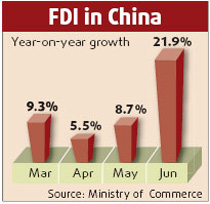The central bank may raise interest rates at least twice in 2008, said both research reports by Bank of China (BOC) and China International Capital Corp (CICC).
In a recent report, BOC said the People's Bank of China will raise interest rates two or three times this year, making the one-year term deposit rate from current 4.14 percent to between 4.68 and 4.95 percent.
After a 5 percent tax deduction on interest income, the one-year fixed-term deposit rate should be between 4.45 and 4.7 percent. If the consumer price index (CPI) grows around 4.5 percent this year as expected, the rate hikes may turn the real interest rate from negative to positive horizons, said the report.
BOC anticipates accelerated renminbi appreciation against the US dollar this year. The appreciation is estimated to eventually be around 8 to 10 percent.
The report said the key to solving the excessive liquidity problem is to keep money from accumulating. However, relieving the pressure quickly is not a possibility in 2008 because of the mounting trade surplus and foreign direct investment (FDI) flooding into China.
The combined trade surplus and FDI is likely to reach $330 billion in 2007 while that for this year could be a little lower, at $300–$240 billion as trade surplus and $60 billion from FDI.
As a result, the central bank may hold as much as 2.1 trillion yuan ($288 billion) funds outstanding in foreign exchange. It is companies and residents that acquire capital through the funds outstanding for foreign exchange. In order to absorb 2.1 trillion yuan from the market, the country has to issue more treasury bonds. As a result, higher returns are needed to attract more buyers, which will drive interest rates higher, BOC said in the report.
CICC seems to agree with BOC in favor of at least two interest rate hikes in 2008. However, it expects more dramatic inflation, with CPI exceeding the widely anticipated 4 to 4.5 percent. It said 2008 CPI could reach 5 to 5.5 percent.
CICC also believes food prices are to maintain double-digit growth in the first half this year. In the meantime, growth rate in non-food prices could accelerate to over 2 percent.
The CICC report projected 6 to 7 percent growth rate in CPI in the first half, with monthly growth of 7 percent at the highest. In the second half, CPI may grow at lower speeds at between 3 and 4 percent. The difference between year-on-year monthly CPI growth may not be as big as in 2007.
The main drivers for 2007 CPI have proven to be prices in meat and poultry, egg and edible oil. CICC believed in the first half this year, prices of the three food categories are not likely to fall quickly. On the contrary, they are likely to climb higher and corn and rice prices may become a new force pushing up CPI figures.
The report said the 4.68 percent nominal interest rate after a few hikes in 2008 may not cover the 5.5 percent CPI growth, which means the real interest rate is still negative for the first half. In the second half, however, when the CPI growth falls down to 3 to 4 percent, the real interest rate could reach 1 percent. CICC said central bank interest rate hikes will be more frequent in the first half than in the second.
(China Daily January 11, 2008)


